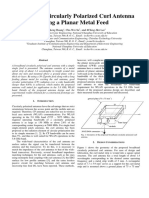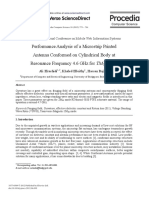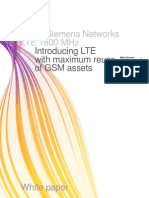Microstrip Annular Ring Slot Antenna! For Mobile Applications
Microstrip Annular Ring Slot Antenna! For Mobile Applications
Uploaded by
mykeenzo5658Copyright:
Available Formats
Microstrip Annular Ring Slot Antenna! For Mobile Applications
Microstrip Annular Ring Slot Antenna! For Mobile Applications
Uploaded by
mykeenzo5658Original Description:
Original Title
Copyright
Available Formats
Share this document
Did you find this document useful?
Is this content inappropriate?
Copyright:
Available Formats
Microstrip Annular Ring Slot Antenna! For Mobile Applications
Microstrip Annular Ring Slot Antenna! For Mobile Applications
Uploaded by
mykeenzo5658Copyright:
Available Formats
0 IEE 1996 1'9 July 1996 Electronics Letters Online No: 19961157 G. Forma and J.M.
Laheurte (Laboratoire d'Electronique, Antennes et Tdlt'communications, Universitt' de Nice - Sophia Antipolis, CNRS, 250 rue Albert Einstein, 06560 Valbonne, France)
References
1 2
GREISER, J.W :
'Coplanar stripline antenna', Microw. J., 1976, 19,
(lo), pp. 47-49
LIU, Y . , CHA, K., and ITOH, T.: 'Non-leaky coplanar (NLC) waveguides with conductor backing', IEEE Trans., 1995, MTT-43, ( 5 ) , pp. 1067-1072 3 GIAUFFRET, L , and LAHEURTE, J.M.: 'Theoretical and experimental characterisation of CPW-fed microstrip antennas'. IEE Proc. Microw. Antennas Propag., 1996, 143, (l), pp. 13-17 4 FORMA, G', and LAHEURTE, J M.: 'CPW-fed oscillating microstrip antennas', Electron. Lett., 1996, 32, (2), pp. 85-86
Microstrip annular ring slot antenna!; for mobile applications
J.C. Batchelor and R.J. Langley
Indexing terms: Microstrip antennas, Antennas, Mobile communication systems
, . h ? , . l , ? J
I___?
Fig. 1 Microstrip annular slot geometry
An annular slot on triplate feed is discussed which is suitable for use with vehicular mobile satellite systems. The slot is excited in a higher order mode and circularly polarised to give a conical radiation pattern. The slot can operate on a high dielectric base and a superstrate improves the gain.
Introduction; One aim of recent work regarding m0bil.e communications is to integrate an antenna with its associated R F circuitry into an MMIC device on silicon or gallium arsenide. Work has been done regarding the annular microstrip ring higher order TM,, mode with a possible application for mobile satellite communications in non-equatorial countries, [11. The higher order microstrip ring modes have a null in the direction normal to the plane of the patch and the TIM,, mode peaks at an elevation of 55" from the azimuthal plane. There are however, some disadvantages with using microstrip radiating elements, namely surface waves giving rise to diffraction from substrate edges, poor radiation efficiencies on high dielectric materials and high crosspolar levels for antennas fed electromagnetically through the substrate with a microstrip feed. To overcome the problems mentioned above an investigation into narrow annular microstrip slot antennas (width < U20) has been carried out to establish the properties of the first higher order mode which has not been reported on before. Slot antenna design: A slot antenna, shown on a triplate feed structure in Fig. 1, has the advantage of reducing cross-polarised fields by screening the feedline while also constraining all radiation to the forward hemisphere. The triplate feed structure can allow parallel plate modes to propagate which may give rise to problematic edge diffraction. Spurious radiation at low elevation angles and ripple in the main beam can be removed by mefallising the substrate edges andlor adding via pins. As the aperture fields exist at the air-dielectric interface, the electrical slot size is virtually unaffected by the dielectric constant of the substrate, a situation very different to that of ;I microstrip antenna where the structures fields permeate through both substrate and free space. The fundamental mode radiation pattern of a microstrip annular slot is well known, with ku = l, where wave number, k = 2nIX and a = average slot radius. This mode radiates with maximum gain in a direction normal to the plane of the slot. The antenna presented in this Letter was designed such that k a = 2, the aperture field distribution being shown in Fig. 2. The triplate feed was formed from Duroid 5870, E, = 2.33 and total height = 1.58mm. Resonance occurred at 7.1GHz for an average slot radius of 13.5mm with a slot width of lmm.
-1 OdBidivision
Fig. 3 Measured radiation pattern?
a Measured radiation patterns, ka = 2 b Radiation patterns with alumina superstrate
- - - -
E-plane H-plane
Slot antennas results; The E- and H-plane patterns were measured and are shown in Fig. 3a. The beam peaks at an elevation of 55" making the antenna suitable for higher latitude satellite applications. A 2:l SWR bandwidth of 2.6% was measured for the mode, a value that compares with that of the microstrip ring in the TM21 mode. The H-plane gain was 4.5dB hgher than that of the Eplane and exhibited asymmetry which was attributed to the feed. Adding an alumina superstrate, E, = 10.4, height = 0.6mm, reduced the feed asymmetry to 0.8dB and also caused the power in the E- and H-planes to equalise (Fig. 3b). Low elevation radiation in the E-plane was increased by the addition of the
ELECTRONICS LETTERS
29th August 1996
Vol. 32
No. 78
1635
superstrate due to diffraction from the alumina edges which were unscreened in this measurement. The resonant frequency was reduced to 6.1 GHz. The peak beam gain of the slot at ka = 2 was measured to be -2.6dBi. This was increased to 4.6dBi by adding the superstrate. A good prediction of the composite dielectric constant, caused by introducing the superstrate is given by eqn. 1 [2]
References c , and LANGLEY, R.J.: 'Microstrip ring antennas operating at higher order modes for mobile communications', ZEE Proc. Microis. Antennas Propagat., 1995, 142, (2), pp. 151-155 2 KARMAKER. N c., and BHATTACHARYYA, A.: 'Electromagnetically coupled patch antenna - theoretical and experimental inLestizations'. .Micron.. & Opt. Technol. Left., 1992, 5, (3), pp.
1
BATCHELOR. J
,
115-1 18
3
HIROSE. K..
and
NAKANO, H.:
'Dual-loop slot antenna with simple
feed'. Election. Left., 1989, 25, (18), pp. 1218-1219
where d and h refer to substrate and superstrate heights, respectively. The slot radius IS then given by
where h, is the wavelength in free space.
Low offset, high voltage class AB bipolar voltage-current converter
G. Stochino
Indexing t e r m : Operational transconductance amplifiers, Linear intepiuted circuits A new high voltage class AB bipolar voltage-current converter (VCCS), which features low offset voltage and is suitable for monolithic IC fabrication. is described. The architecture of the converter is particularly suited for the implementation of a precision VCCS with wide input and output voltage range. Some SPICE siinulations and experiiental results are also reported, w h c h demonstrate the effectiveness of the proposed
configuration.
Introduction: In a recent Letter [I] some circuit configurations for Fig. 4 Circularly polarised far-field immurement
Circularly polarised slot antennas: To be of practical use; a mobile antenna used in conjunction with a satellite system would need to be circularly polarised. Budgetary constraints in receiver manufacture require components to be inexpensive and so a non-complex method for producing circular polarisation was sought. A simple way to excite circularly polarised fields from annular slots operating at the ku = 1 mode has been reported by [3] where notches are placed 45" and 225" from the feed point. Fig. 4 shows a far field measurement extrapolated from the near field of the ka = 2 antenna, where four 2mm x 2mm notches were placed midway between the E- and H-planes at 22.5" and 112.5" from the feed. It can be seen that the radiation field was conical in all planes, the field independence around the azimuthal plane making the antenna suitable for mobile applications. Peak beam axial ratio was measured to be less than 3dB. Use of the notches removed the necessity to provide orthogonally phased feedlines beneath the slot and so reduced the component complexity significantly.
high speed class AB voltage controlled current sources (VCCS), %hich feature improved conversion accuracy, were proposed and discussed. However. the intrinsic input offset voltage and output offset current of these configurations are not better than their conventional counterpart. The aim of this Letter is to propose a new bipolar class AB VCCS architecture which, in addition to good conversion accuracy, provides improved offset figures and is particularly suitable for wide inpuvoutput voltage range implementations.
"cc
*-
7 7 - --
Conclusion: A slot antenna operating at a higher order mode has been proposed with a possible application for mobile systems as an alternative to microstrip antennas. The slot antenna has an advantage over microstrip patches because of the screened feed which prevents spurious radiation. Higher order mode fields can be excited that are both circularly polarised and conical in shape. Gains of over 4dB were measured when an alumina superstrate was added. A strong advantage of this type of antenna is its lack of dependency on the dielectric substrate making it suitable for integration with high E, semiconductor materials, a development of considerable interest to recent mobile communication design.
Acknowledgment: This work was supported by grants from the
<-L
VA
_ . _
IA
Fig. 1 Basic architecture of the proposed high speed, low offset, class A B voltage-current converter
UK Engineering and Physical Science Research Council.
0 IEE 1996
Electronics Letters Online No: 19961102
28 June 1996
The few high voltage devices are labelled (HV)
Circuit description: The architecture of the proposed new VCCS is shown in Fig. 1. Transistors Q3,Q4 and Qg in the upper half, and Q7,Q8 and QI0in the lower half, are connected to form two complementary Wilson current mirrors, which are driven by input
J.C. Batchelor and R.J. Langley (University of Kent, Cunterbury, Kent C T 2 7NT, United Kingdom)
1636
ELECTRONICS LETTERS
29th August 1996
Vol. 32
No. 18
You might also like
- Ursi03 AntDocument5 pagesUrsi03 AntBezawada PrabhakarNo ratings yet
- 3 v49-63Document5 pages3 v49-63Chandrahasa ReddyNo ratings yet
- Progress in Electromagnetics Research, Vol. 120, 499-512, 2011Document14 pagesProgress in Electromagnetics Research, Vol. 120, 499-512, 2011Mario2545No ratings yet
- Wideband Magnetoelectric Dipole Antennas With Dual Polarization and Circular PolarizationDocument10 pagesWideband Magnetoelectric Dipole Antennas With Dual Polarization and Circular PolarizationAshim ChakrabortyNo ratings yet
- Sequential RotationDocument4 pagesSequential RotationindameantimeNo ratings yet
- Progress in Electromagnetics Research C, Vol. 6, 93-102, 2009Document10 pagesProgress in Electromagnetics Research C, Vol. 6, 93-102, 2009amit ranjanNo ratings yet
- Simulation of A Rectangular Patch AntennaDocument9 pagesSimulation of A Rectangular Patch AntennaragvshahNo ratings yet
- International Journal of Engineering Research and DevelopmentDocument14 pagesInternational Journal of Engineering Research and DevelopmentIJERDNo ratings yet
- Stacked Patch Excited Horn Antenna at 94 GHZDocument4 pagesStacked Patch Excited Horn Antenna at 94 GHZspygrigNo ratings yet
- Reconfigurable Microstrip Patch Antenna With Switchable PolarizationDocument6 pagesReconfigurable Microstrip Patch Antenna With Switchable Polarizationsaurabh gondNo ratings yet
- Millimeter-Wave Dual-Band Microstrip Patch Antennas Using Multilayer Gaas TechnologyDocument4 pagesMillimeter-Wave Dual-Band Microstrip Patch Antennas Using Multilayer Gaas TechnologyShivanandKalmaniNo ratings yet
- Simple Reconfigurable Antenna With Radiation Pattern: W.S. Kang, J.A. Park and Y.J. YoonDocument2 pagesSimple Reconfigurable Antenna With Radiation Pattern: W.S. Kang, J.A. Park and Y.J. YoonSefa KorogluNo ratings yet
- Cognetive RedioDocument10 pagesCognetive RedioNIET14No ratings yet
- Novel Planar Wideband Omni-Directional Quasi Log-Periodic AntennaDocument4 pagesNovel Planar Wideband Omni-Directional Quasi Log-Periodic Antennamano012No ratings yet
- The Effect of Miniaturized Circular Antennas On The SAR Reduction For Wireless ApplicationsDocument25 pagesThe Effect of Miniaturized Circular Antennas On The SAR Reduction For Wireless Applicationsyoussef.amraoui2No ratings yet
- Performance Analysis of Microstrip Patch Antenna Using Coaxial Probe Feed TechniqueDocument3 pagesPerformance Analysis of Microstrip Patch Antenna Using Coaxial Probe Feed TechniqueInternational Jpurnal Of Technical Research And Applications100% (1)
- 8.design of An S-Band Rectangular Microstrip Patch AntennaDocument8 pages8.design of An S-Band Rectangular Microstrip Patch Antennasrinivas08427No ratings yet
- A Compact Diversity Antenna For Handheld TerminalsDocument3 pagesA Compact Diversity Antenna For Handheld TerminalsKusparyono Bin SalamNo ratings yet
- Design of Compact Antenna With Modified Ground Plane For Ultra Wide Band CommunicationDocument4 pagesDesign of Compact Antenna With Modified Ground Plane For Ultra Wide Band CommunicationInternational Journal of Application or Innovation in Engineering & ManagementNo ratings yet
- Circularly Polarized ArrowheadDocument12 pagesCircularly Polarized ArrowheadNatwar LalNo ratings yet
- Cpw-Fed Slot Patch Antenna For 5.2/5.8 GHZ Wlan ApplicationDocument3 pagesCpw-Fed Slot Patch Antenna For 5.2/5.8 GHZ Wlan ApplicationWish MasterNo ratings yet
- A CPW-Fed Novel Planar Ultra-Wideband Antenna With A Band-Notch CharacteristicDocument5 pagesA CPW-Fed Novel Planar Ultra-Wideband Antenna With A Band-Notch CharacteristicarbtepNo ratings yet
- Design, Simulation and Fabrication of A Microstrip Patch Antenna For Dual Band ApplicationDocument4 pagesDesign, Simulation and Fabrication of A Microstrip Patch Antenna For Dual Band Applicationizzad razaliNo ratings yet
- Metodos de DiseñoDocument4 pagesMetodos de DiseñoAlex Jarrin RNo ratings yet
- Band-Notched UWB Antenna Incorporating A Microstrip Open-Loop ResonatorDocument4 pagesBand-Notched UWB Antenna Incorporating A Microstrip Open-Loop ResonatorarbtepNo ratings yet
- A Wideband Circular Patch Antenna: D and AirDocument2 pagesA Wideband Circular Patch Antenna: D and Airحماد حسينNo ratings yet
- Stacked Coupled Circular Microstrip Patch Antenna For Dual Band ApplicationsDocument4 pagesStacked Coupled Circular Microstrip Patch Antenna For Dual Band ApplicationsMohammed LarbiNo ratings yet
- A Dual-Feed Dual-Band L-Probe Patch AntennaDocument3 pagesA Dual-Feed Dual-Band L-Probe Patch AntennaCRoberto Wah GonzalezNo ratings yet
- Ijecet: International Journal of Electronics and Communication Engineering & Technology (Ijecet)Document5 pagesIjecet: International Journal of Electronics and Communication Engineering & Technology (Ijecet)IAEME PublicationNo ratings yet
- Ramirez 2000Document8 pagesRamirez 2000avneet sandhuuuNo ratings yet
- 9 - 06711979 A Novel UWB CircularDocument4 pages9 - 06711979 A Novel UWB CircularZeeshan AhmedNo ratings yet
- Review of Some Investigations On Rectangular Microstrip Antennas With Embedded SlotsDocument8 pagesReview of Some Investigations On Rectangular Microstrip Antennas With Embedded SlotsInternational Journal of Application or Innovation in Engineering & ManagementNo ratings yet
- 8 Vol 17 No 2Document7 pages8 Vol 17 No 2Sanjay SumanNo ratings yet
- Antena Slot HDocument5 pagesAntena Slot HRakhmatTeguhNo ratings yet
- Heuristic Design of CPW-Fed UWB Slot AntennaDocument4 pagesHeuristic Design of CPW-Fed UWB Slot Antennaaboabdo1No ratings yet
- A 60-Ghz LTCC Antenna Design W Rectangular Dielectric R With Characteristic Mode Resonator Es TheoryDocument2 pagesA 60-Ghz LTCC Antenna Design W Rectangular Dielectric R With Characteristic Mode Resonator Es TheoryTommy BJNo ratings yet
- THZ Rectangular Patch Microstrip Antenna Design Using Photonic Crystal As SubstrateDocument5 pagesTHZ Rectangular Patch Microstrip Antenna Design Using Photonic Crystal As SubstrateengrkskNo ratings yet
- New Multi-Band Microstrip Antenna Design For Wireless CommunicationsDocument6 pagesNew Multi-Band Microstrip Antenna Design For Wireless CommunicationsPECMURUGANNo ratings yet
- Design of A CPW-Fed Ultra Wide Band Antenna: Shaowen Hu, Yiqiang Wu, Ye Zhang, Huilin ZhouDocument5 pagesDesign of A CPW-Fed Ultra Wide Band Antenna: Shaowen Hu, Yiqiang Wu, Ye Zhang, Huilin ZhouAyman YounisNo ratings yet
- Patch AntennaDocument9 pagesPatch AntennaNeha GoyalNo ratings yet
- CPW-Fed Capacitive Coupled Slot Antenna: Nternational Ournal of Nnovative Esearch in Omputer and Ommunication NgineeringDocument6 pagesCPW-Fed Capacitive Coupled Slot Antenna: Nternational Ournal of Nnovative Esearch in Omputer and Ommunication NgineeringNag ChallaNo ratings yet
- Design Analysis of Slotted Diagonal Shape Patch Antenna With Hybrid CouplerDocument6 pagesDesign Analysis of Slotted Diagonal Shape Patch Antenna With Hybrid CouplerIJERDNo ratings yet
- Electronics-13-02749 TechnologyDocument10 pagesElectronics-13-02749 Technologyjamel-shamsNo ratings yet
- Efficient 2.45 GHZ Rectenna Design With High Harmonic Rejection For Wireless Power TransmissionDocument4 pagesEfficient 2.45 GHZ Rectenna Design With High Harmonic Rejection For Wireless Power TransmissionEk RishtaaNo ratings yet
- High Gain Substrate Slütted Micrüstrip Patch Antenna Design Für X-Band Satellite Uplink ApplicatiünsDocument5 pagesHigh Gain Substrate Slütted Micrüstrip Patch Antenna Design Für X-Band Satellite Uplink ApplicatiünsKarthik DevarajanNo ratings yet
- 0 - A Broadband Solar Antenna Element For Base StationDocument3 pages0 - A Broadband Solar Antenna Element For Base Stationanwenxing1984No ratings yet
- A Novel Compact Ultra-Wideband Rectangular Shaped AntennaDocument5 pagesA Novel Compact Ultra-Wideband Rectangular Shaped AntennaBilal SaleemNo ratings yet
- Broadband Circularly Polarized Curl Antenna Using A Planar Metal FeedDocument3 pagesBroadband Circularly Polarized Curl Antenna Using A Planar Metal Feed蘇哲No ratings yet
- Designs On Cpw-Fed Aperture Antenna For Ultra-Wideband ApplicationsDocument6 pagesDesigns On Cpw-Fed Aperture Antenna For Ultra-Wideband ApplicationsSudesh AgrawalNo ratings yet
- Elrashidi2012 PDFDocument10 pagesElrashidi2012 PDFGurulakshmi A BNo ratings yet
- Miniaturised Coplanar Waveguide-Fed Antenna and Band-Notched Design For Ultra-Wideband ApplicationsDocument13 pagesMiniaturised Coplanar Waveguide-Fed Antenna and Band-Notched Design For Ultra-Wideband ApplicationsbudituxNo ratings yet
- Progress in Electromagnetics Research Letters, Vol. 31, 97-105, 2012Document9 pagesProgress in Electromagnetics Research Letters, Vol. 31, 97-105, 2012iccwcsNo ratings yet
- Design and Performance Evaluation of Skew-Planar Antenna For UAV Application 2.4 GHZ BandDocument4 pagesDesign and Performance Evaluation of Skew-Planar Antenna For UAV Application 2.4 GHZ BandArdhian Ainul YaqinNo ratings yet
- Radio Propagation and Adaptive Antennas for Wireless Communication Networks: Terrestrial, Atmospheric, and IonosphericFrom EverandRadio Propagation and Adaptive Antennas for Wireless Communication Networks: Terrestrial, Atmospheric, and IonosphericNo ratings yet
- Vacuum Nanoelectronic Devices: Novel Electron Sources and ApplicationsFrom EverandVacuum Nanoelectronic Devices: Novel Electron Sources and ApplicationsNo ratings yet
- Electrically Small, Superdirective, and Superconducting AntennasFrom EverandElectrically Small, Superdirective, and Superconducting AntennasNo ratings yet
- TH-VN DVB-T t2 Brochure Cdt5105d-1Document5 pagesTH-VN DVB-T t2 Brochure Cdt5105d-1mykeenzo5658No ratings yet
- Making Games With Python & PygameDocument368 pagesMaking Games With Python & PygameNikola Nojic100% (1)
- Atdi Irf NFD White PaperDocument5 pagesAtdi Irf NFD White Papermykeenzo5658No ratings yet
- Technical Planning BWADocument27 pagesTechnical Planning BWAmykeenzo5658No ratings yet
- Atdi Irf NFD White PaperDocument5 pagesAtdi Irf NFD White Papermykeenzo5658No ratings yet
- Coverage Prediction and Planning Software For DVB TV - ITU RecDocument39 pagesCoverage Prediction and Planning Software For DVB TV - ITU Recmykeenzo5658No ratings yet
- Interference Identification CDMADocument130 pagesInterference Identification CDMAmykeenzo5658No ratings yet
- PBG-Assisted Gain Enhancement of Patch Antennas On High-Dielectric Constant SubstrateDocument4 pagesPBG-Assisted Gain Enhancement of Patch Antennas On High-Dielectric Constant Substratemykeenzo5658No ratings yet
- Downlink Resource Allocation in Long Term Evolution (LTE) : KeywordsDocument6 pagesDownlink Resource Allocation in Long Term Evolution (LTE) : Keywordsmykeenzo5658No ratings yet
- NSN Lte 1800 MHZ White Paper - 0.9Document11 pagesNSN Lte 1800 MHZ White Paper - 0.9schabrackentapirNo ratings yet




































































